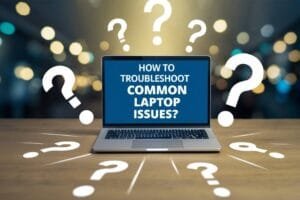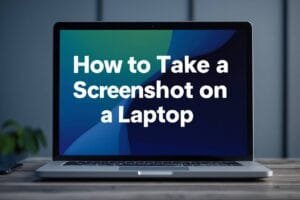A sudden black screen on a laptop feels catastrophic—like the machine just “gave up.” The good news: in most cases, it’s fixable, and many fixes take only a few minutes. This guide walks you through every practical step, from super-fast checks to advanced repairs—organized so you can stop as soon as your display springs back to life.
Whether you’re on Windows, macOS, ChromeOS, or Linux, you’ll find specific paths for your platform, along with universal hardware checks that apply to all laptops. Keep this page open on your phone or a second device and go one section at a time.
TL;DR: Quick Wins (Try These First)
If you’re in a hurry, do these in order. Stop when the screen returns:
- Force restart the laptop
- Press and hold the power button for 15–20 seconds.
- Unplug the charger and remove the battery (if removable). Wait 1 minute, then reconnect and power on.
- Brightness, display output, and lid sensor
- Tap the brightness keys.
- On Windows, press Win + P, then tap the up/down arrows and hit Enter to switch display modes (“PC screen only,” “Duplicate,” etc.).
- Slowly open/close the lid to check if the lid/ambient light sensor is stuck.
- Use a flashlight at an angle toward the screen—if you faintly see the desktop, the backlight is likely off (keep reading).
- External display test
- Connect to a monitor/TV via HDMI/USB-C/DisplayPort.
- If the external display works, the GPU may be fine; focus on the laptop panel, cable, or backlight.
- Disconnect everything
- Remove USB drives, SD cards, docking stations, and external GPUs.
- Try booting again—peripherals can hijack display or stall boot.
- Windows-only: reset the graphics driver
- Press Win + Ctrl + Shift + B. You should hear a beep; the screen may blink. If it returns—great.
- Battery and static discharge
- Unplug power. Hold power for 30–45 seconds to discharge capacitors. Reconnect, try again.
If none of that helps, keep going—systematically.
Quick Symptom → Fix Matrix (All Laptops) Fast actions first • hardware/software
| Symptom | Likely cause | 60-second checks | Next step |
|---|---|---|---|
| No lights/fan, totally dead | Power brick/outlet, DC-in, motherboard rail | Try another outlet/charger; hold power 30–45s | Reseat/removable battery; pin-hole reset; service DC-in/mobo |
| Fans/keyboard light, no logo | Unseated RAM, GPU init, display cable | Hard power cycle; remove all USB/SD/docks | Reseat RAM (one stick at a time); external monitor; BIOS reset |
| Black screen + mouse cursor | Explorer/shell crash, GPU driver hang | Ctrl+Shift+Esc → Run explorer.exe; Win+Ctrl+Shift+B |
Safe Mode; roll back/clean-install GPU; disable Fast Startup |
| Faint image with flashlight | Backlight fuse/LED/cable | Flashlight at angle to confirm | Panel/backlight/cable service; external display workaround |
| External works; laptop panel black | LCD panel/cable/backlight | Win+P cycle modes; set internal primary | Reseat/replace LCD ribbon; hinge inspection; panel/backlight |
| Black after sleep/wake | Fast Startup/Modern Standby, driver power state | Disable Fast Startup; update GPU/BIOS | Disable hybrid sleep; clean GPU install; OS repair if needed |
| Black after update | Bad GPU/feature update | Win+Ctrl+Shift+B; Safe Mode | Roll back/uninstall update; DDU clean; System Restore |
| Screen blinks when moving lid | Hinge-area cable fracture/loose | Open/close slowly to reproduce | Reseat/replace LCD cable; hinge service |
| Beep/LED error codes | RAM/GPU/board fault per code | Note pattern for manual | Reseat RAM/SSD; follow vendor code; service if persists |
| Power cuts out immediately | Thermal trip, short, liquid damage | Check vents; listen for fan surge | Clean dust; repaste/service; inspect for liquid/short |
Legend Win+Ctrl+Shift+B = Windows GPU reset • Win+P = switch display modes
Windows 10/11 — Fast Actions Map Driver, update, and boot fixes
| Symptom | One-key action | Then do this |
|---|---|---|
| Black with cursor after login | Ctrl+Shift+Esc → File → Run explorer.exe |
Disable Fast Startup; remove overlays (RGB/FPS/remote); update/roll back GPU |
| Suspect GPU hang | Win+Ctrl+Shift+B | Safe Mode → DDU clean → install OEM/NVIDIA/AMD/Intel driver |
| Nothing on laptop, external OK | Win+P to cycle blindly | Set internal primary; install OEM display/graphics; check cable/backlight |
| Stuck pre-login after updates | Force 3 failed boots → WinRE | Startup Repair → System Restore → Uninstall latest Quality Update |
| Black after wake/sleep | Disable Fast Startup | Disable hybrid sleep; BIOS/firmware update; clean GPU install |
| No OS load (boot records) | — | WinRE → CMD: bootrec /fixmbr, /fixboot, /scanos, /rebuildbcd → sfc /scannow |
| Hidden BitLocker prompt | Attach external display | Enter key; set internal primary; suspend BitLocker during driver work |
macOS (MacBook) — Fast Actions Map Apple silicon & Intel
| Symptom | Quick action | Next step |
|---|---|---|
| Black screen, keyboard lights on | Hold Power 10s (force off) → power on | Safe Mode: hold Power → Startup Options → hold Shift → Continue in Safe Mode |
| M-series shows no image | Safe Mode via Startup Options | Recovery → Reinstall macOS (non-destructive); use external display to isolate panel |
| Intel Mac: black screen | NVRAM reset: ⌥⌘PR (20s) | SMC reset; Safe Mode; Disk Utility First Aid; external/backlight check |
| Faint image visible | — | Backlight/panel service |
| No power signs | Try other USB-C ports/charger | Long press power; charge 15–20 min; Apple Diagnostics/service |
Chromebook — Fast Actions Map Hard reset & recovery
| Symptom | Quick action | Next step |
|---|---|---|
| Black, device powers | Refresh (⟳) + Power (hard reset) | External display; EC reset (hold Refresh + Power longer on some models) |
| Still black after reset | — | Recovery: Power off → Esc + Refresh + Power → reinstall ChromeOS |
| Internal black, external OK | — | Panel/cable/backlight service |
Linux — Fast Actions Map Display manager & kernel
| Symptom | Quick action | Next step |
|---|---|---|
| Black GUI, system alive | Ctrl+Alt+F2 (TTY) login | systemctl restart gdm/sddm/lightdm; switch Wayland↔Xorg; check .xsession-errors |
| After kernel/driver update | From GRUB: boot previous kernel | Purge/reinstall NVIDIA (apt purge 'nvidia*' → ubuntu-drivers autoinstall); rebuild initramfs |
| No TTY either | — | GRUB → add nomodeset once; then fix drivers; try external display |
Understand the Black Screen: Common Root Causes
Before diving deeper, it helps to know what you’re hunting:
- Power & firmware: Low/unstable power, fast startup glitches, corrupt BIOS/UEFI settings.
- Display path: Broken or loose LCD cable, failed backlight, faulty inverter (older models), damaged panel.
- Graphics & drivers: Crashed GPU, broken drivers (especially after Windows Update or driver installs).
- OS & boot issues: Corrupt system files, stuck after login, explorer/shell not launching, profile or malware problems.
- Peripherals & docks: Devices that steal primary display or block boot.
- Thermal & mechanical: Overheating shutdowns, liquid damage, or a hairline hinge cable tear that kills the panel at certain lid angles.
- Storage/RAM: Incomplete boots due to bad RAM or failing SSD (screen may stay black with fans running).
This guide moves from lowest-risk to higher-impact steps so you don’t do invasive work unless necessary.
Part 1 — Universal Hardware Checks (All Laptops)
1) Power sanity check (2–3 minutes)
- Confirm the charger LED is on and warm to touch (not hot).
- Try a different wall outlet and, ideally, a different compatible charger.
- Check battery LEDs on the laptop (if present). No indicator may still be normal, but look for blinking error patterns in brand manuals.
Pro tip: Some laptops won’t power the panel if the battery is critically low. Leave it charging for 10–15 minutes, then try again.
2) Hard power cycle & static discharge (2 minutes)
- Unplug the charger; if the battery is removable, remove it.
- Hold the power button 30–45 seconds (drains residual power).
- Reattach the battery, plug in, and power on.
3) External display test (5 minutes)
- Plug in an external monitor/TV.
- Cycle display modes:
- Windows: Win + P → arrows → Enter.
- macOS: Connect the display; press Command (⌘) + F1 on some older Macs or use System Settings once you can see.
- ChromeOS:
Ctrl + Full Screenor use Settings when visible.
- If external works:
- Likely panel, cable, hinge wire, or backlight issue.
- You can work temporarily on the external monitor while arranging repairs or parts.
4) The flashlight test (1 minute)
Shine a phone flashlight at an angle across the screen. If you see a faint desktop:
- The LCD is rendering, but the backlight isn’t.
- Causes: blown backlight fuse, failed LED strip, bad cable, or motherboard power to backlight. This is a hardware repair; seek a technician if under warranty.
5) Lid angle & hinge wiggle (1 minute)
Slowly move the lid. If the screen blinks on/off at certain angles:
- The display cable is likely loose or fractured at the hinge.
- Fix: reseating/replacing the LCD ribbon cable. This is a common, inexpensive repair.
6) Reseat or swap RAM (10–15 minutes; advanced but safe)
Bad or partially unseated RAM can prevent the display from initializing.
- Power off, disconnect power.
- Open the access panel (if your model allows).
- Remove and reinsert RAM sticks; try one stick at a time in different slots.
- If the black screen resolves with one stick, the other is suspect.
7) Thermal/laptop fan check (2 minutes)
- Power on and listen: fans spinning? If it immediately shuts off, the CPU may be overheating or a thermal safety is tripping.
- Blow out vents with compressed air; ensure the vents aren’t blocked.
8) Signs of deeper board failure
- No LEDs, no fan, no charging light: suspect charger, DC-in jack, power rail, or motherboard.
- Replacing the charger is the quickest elimination test.
If hardware checks don’t solve it, move to software/OS paths below.
Part 2 — Windows 10/11: Step-by-Step
Snapshot of common Windows scenarios
- Black screen with cursor after login → often explorer.exe or shell value issue, GPU driver crash, or Fast Startup glitch.
- Black screen before login → display mode mismatch, GPU driver panic, startup service conflict, or system file corruption.
- Black screen after an update → known with some GPU/feature updates; rollback/repair helps.
A. Fast, reversible resets
1) Reset the graphics driver
- Press Win + Ctrl + Shift + B (beep + screen flash). Works in many driver hangs.
2) Cycle display modes
- Win + P → try each mode blindly (“Duplicate,” “Extend,” “Second screen only”).
- Hit arrows then Enter, wait 5–10 seconds between cycles.
3) Turn off Fast Startup (once you can see)
- Control Panel → Power Options → “Choose what the power buttons do.”
- Click “Change settings that are currently unavailable.”
- Uncheck “Turn on fast startup.”
- Save. This avoids future black screens on boot.
B. If you see only a cursor (post-login black screen)
Try to relaunch Explorer
- Press Ctrl + Shift + Esc to open Task Manager. If it doesn’t appear, try Ctrl + Alt + Del → Task Manager.
- File → Run new task → type
explorer.exe→ Enter. - If the desktop returns, update GPU drivers, disable startup items that recently changed, and run a full malware scan.
Check shell registry (advanced; do only if comfortable)
- Task Manager → File → Run →
regedit - Navigate:
HKEY_LOCAL_MACHINE\SOFTWARE\Microsoft\Windows NT\CurrentVersion\Winlogon - The Shell value should be
explorer.exe(exactly). If it’s something else, correct it.
C. Boot to Safe Mode (to fix drivers & services)
Method 1: Three failed boots → WinRE
- Force power off during the Windows logo 2–3 times to trigger Windows Recovery Environment.
- Troubleshoot → Advanced options → Startup Settings → Restart.
- Press 4 (Safe Mode) or 5 (Safe Mode with Networking).
Method 2: From a visible session
- Press Win + R, type
msconfig, Enter → Boot tab → check Safe boot (Minimal) → Apply → Restart.
In Safe Mode, do the following:
- Roll back GPU driver (Device Manager → Display adapters → your GPU → Properties → Driver → Roll Back Driver).
- Or uninstall the GPU driver (check “Delete the driver software”), then reboot and install a known-good version from your GPU vendor (Intel/NVIDIA/AMD).
- Disable problematic startup apps: Task Manager → Startup tab → disable anything recently installed (RGB tools, screen recorders, third-party shells).
- Create a new user profile (to rule out a corrupt user profile): Settings → Accounts → Family & other users → Add. Log in with the new user to test.
D. Repair Windows system files
Option 1: SFC + DISM (when you can reach desktop/Safe Mode)
Open Command Prompt as Administrator:
DISM /Online /Cleanup-Image /RestoreHealth
sfc /scannow
- Reboot after SFC completes.
Option 2: From WinRE Command Prompt
- Troubleshoot → Advanced options → Command Prompt
- You’ll need to identify your system drive letter (often
C:but can change in WinRE). - Then run the same
DISMandSFCcommands.
E. Startup Repair & System Restore
Automatic Repair
- WinRE → Troubleshoot → Advanced options → Startup Repair.
System Restore
- WinRE → Troubleshoot → Advanced options → System Restore.
- Choose a restore point before the black screen began.
Uninstall recent quality/feature updates
- WinRE → Uninstall Updates → Try uninstalling the latest Quality Update first.
F. Black screen after login due to display scaling or resolution
Sometimes Windows sets an invalid resolution for the internal panel.
- In Safe Mode, go to Display settings → set a native resolution and 100–125% scaling.
- Update GPU drivers and check the laptop manufacturer’s display driver too.
G. BIOS/UEFI & firmware touches (do carefully)
Reset BIOS/UEFI to defaults
- Power on → immediately press the vendor key (F2/F10/Del/Esc varies).
- Load defaults (“Optimized Defaults”) → Save & Exit.
Disable hybrid/switchable graphics (for testing)
- Some BIOS offer iGPU only mode. If enabling iGPU brings the panel back, the dGPU path is suspect (driver or hardware).
Update BIOS/UEFI
- Only do this on stable power and if the update notes mention display/graphics/boot fixes.
Part 3 — macOS (MacBook Air/Pro)
Quick triage
- Power cycle: Press and hold the power button for 10 seconds.
- Check charging: MagSafe/USB-C indicator, try another charger and port.
- External display test: Connect via USB-C/HDMI; if external works, panel/backlight/cable is the likely culprit.
A. Apple silicon (M-series) Macs
- Force shutdown: Hold power 10 seconds.
- Safe Mode:
- Turn off. Press and hold power until “Loading startup options.”
- Select your disk, hold Shift, click “Continue in Safe Mode.”
- NVRAM resets automatically; there’s no manual PRAM/SMC reset like Intel.
- Reinstall macOS (non-destructive):
- Startup options → Recovery → Reinstall macOS. Your files stay intact, but always have backups.
B. Intel Macs
- Reset NVRAM/PRAM:
- Power on and immediately hold Option + Command + P + R for ~20 seconds.
- Reset SMC (Intel only):
- Varies by model, but generally:
- Shut down → hold Shift + Control + Option (left side) + Power for 10 seconds → release → power on.
- Varies by model, but generally:
- Safe Mode:
- Power on; hold Shift until login appears.
- If display is still black but you can faintly see the desktop with a flashlight, suspect backlight (inverter on older Intel models).
macOS recovery & fixes
- Disk Utility → First Aid on the startup disk.
- Reinstall macOS from Recovery (keeps data).
- Create a new user from Safe Mode to rule out profile corruption.
Part 4 — ChromeOS (Chromebooks)
Steps to try
- Hard reset: Press Refresh (⟳) + Power.
- EC (embedded controller) reset: For some models, hold Refresh + Power longer (check your brand’s instructions).
- External monitor: If external works, internal panel/backlight is suspect.
- Recovery mode: Power off → hold Esc + Refresh and tap Power → follow on-screen prompts to reinstall ChromeOS.
- You’ll need a second computer to create a recovery USB if prompted.
Part 5 — Linux (Ubuntu, Fedora, Arch, etc.)
Linux black screens often follow kernel updates or GPU driver changes. Typical culprits: display manager failures or NVIDIA driver mismatches.
Quick access via TTY
- Press Ctrl + Alt + F2 (or F3/F4). If you get a login prompt, the GPU/display manager is the issue—not the whole system.
Common paths
- Restart display manager (depends on distro):
sudo systemctl restart gdm(GNOME)sudo systemctl restart sddm(KDE)sudo systemctl restart lightdm(older/others)
- Rebuild initramfs or roll back a kernel from GRUB’s “Advanced options.”
- NVIDIA users:
- If you recently updated, purge and reinstall a version known to work:
sudo apt purge 'nvidia*'sudo ubuntu-drivers autoinstall(Ubuntu)
- If you recently updated, purge and reinstall a version known to work:
- Wayland vs Xorg: try switching sessions at the login screen (gear icon) when you get display back.
Part 6 — When the Laptop Powers On but Won’t Show Anything
This is the classic “fans spin, keyboard lights up, but screen stays black.”
1) Listen and look for life signs
- Caps Lock toggles? Keyboard backlight?
- Drive activity LED blinking?
- Startup chime/beeps? Beep codes map to hardware faults (RAM, GPU). Check your brand’s service manual.
2) Reseat storage (SSD) and RAM
- Intermittent SSD connections can block boot splash from appearing.
- Carefully reseat the NVMe/SATA drive and RAM.
3) CMOS/RTC reset (advanced)
- Some laptops have a pin-hole reset on the bottom.
- Others require disconnecting the RTC coin-cell battery briefly to clear BIOS.
- Only if you’re comfortable opening the chassis (and not in warranty).
4) GPU failure signs
- External monitor also shows nothing; fans run loud; system cycles power—these are red flags.
- If your model has a known dGPU issue, try BIOS setting to iGPU only (if available) to test.
Part 7 — Data Safety & Backups (If You’re Worried About Files)
Before you do anything invasive, consider safeguarding your data.
- Bootable USB:
- Create a Windows installer, macOS installer, or Linux live USB on another computer.
- Boot from it and copy files to an external drive.
- Drive enclosure:
- Remove the laptop SSD, place it in a USB NVMe/SATA enclosure, and copy your files from a working computer.
Part 8 — Brand-Specific Nuggets (Dell, HP, Lenovo, ASUS, Acer, MSI, Surface)
- Dell/HP/Lenovo: Often support LED blink/beep codes—quickly reveals RAM/GPU/board issues. Their support sites list exact patterns.
- ASUS/MSI: Pay attention to Armoury Crate/Dragon Center tweaks; restore defaults if display broke after a profile change.
- Acer: Some models have a pinhole reset; check the bottom case for a tiny unlabeled hole.
- Microsoft Surface: Try Volume Up + Power for UEFI; also a two-button shutdown (hold power 30 seconds, then press power normally) can clear stubborn black screens.
Part 9 — Advanced Windows Fixes (If You’re Still Stuck)
A. Clean reinstall GPU drivers (DDU method)
If you repeatedly get a black screen post-login, fully clean and reinstall drivers.
- Boot into Safe Mode.
- Download Display Driver Uninstaller (DDU) on another PC and move it over.
- Run DDU to remove NVIDIA/AMD/Intel graphics drivers.
- Reboot and install manufacturer-recommended GPU drivers (avoid Windows Update’s generic versions initially).
- Turn off Fast Startup again.
B. Repair Boot Records (WinRE Command Prompt)
If the system tries to boot but never reaches the login screen:
bootrec /fixmbr
bootrec /fixboot
bootrec /scanos
bootrec /rebuildbcd
- Then run
sfc /scannowand reboot.
C. Disable/Remove recent software that hooks the display stack
Remote control apps, screen overlay tools (FPS counters, RGB overlays), or antivirus with screen shields can cause black screens. Uninstall them in Safe Mode.
D. Check for BitLocker/Drive Encryption prompts (hidden)
Sometimes BitLocker prompts await input on a hidden display (e.g., external monitor only). Attach an external monitor to reveal it.
Part 10 — When It’s Time to Stop and Call a Pro
Call a technician or your brand’s service line if:
- The flashlight test shows a working image but no backlight (hardware replacement).
- The display flickers with lid movement (likely cable/hinge damage).
- You hear repeating beeps or see error LED patterns.
- There’s liquid damage or a burnt smell.
- You’ve tried Safe Mode, driver rollbacks, System Restore, and still get a black screen both internally and externally.
If the laptop’s under warranty, avoid opening the chassis; focus on software-level fixes and external display testing, then file a claim.
Preventing Black Screens in the Future
- Update drivers sensibly: Prefer manufacturer GPU drivers over random auto-updaters.
- Create restore points before big Windows updates.
- Avoid forced power-offs during updates.
- Keep vents clear; heat kills components over time.
- Use quality chargers; inconsistent power bricks cause weird boot/display behavior.
- Handle lids gently; hinge stress is a leading cause of cable failure.
FAQs
Q: My laptop powers on, fans spin, but I only see a black screen—no logo. What’s the most likely culprit?
A: Hardware. Start with RAM reseat, then try external display, then suspect LCD cable/backlight. Software issues usually still show a logo.
Q: I see a black screen with a white cursor. How do I fix it?
A: That’s often Windows Explorer not launching. Try Ctrl + Shift + Esc → Run → explorer.exe. Then update GPU drivers and disable Fast Startup.
Q: The screen is black only after sleep.
A: Disable Fast Startup, update GPU drivers, and turn off hybrid sleep/Modern Standby if your model misbehaves with it.
Q: I can see the desktop with a flashlight.
A: That’s a dead backlight path. You’ll need hardware service (backlight fuse, LED strip, or cable/panel).
Q: External monitor works; laptop screen is dead.
A: You’ve isolated the issue to the panel/cable/backlight. Keep using the external screen short-term and plan a panel/cable repair.
Q: Will reinstalling Windows/macOS delete my data?
A: A repair install (Windows) or reinstall from Recovery (macOS) keeps data, but always back up first.
Printable Troubleshooting Checklist
Power & Basics
- Charger LED on; tried a second charger/outlet
- Hard power cycle (hold power 30–45s)
- Remove all peripherals & docks
- Brightness keys toggled; Win + P cycled (Windows)
Display Isolation
- External monitor tested (works / doesn’t)
- Flashlight test (faint image = backlight issue)
- Lid angle affects the display (hinge/cable suspect)
Windows Fixes
- Win + Ctrl + Shift + B (driver reset)
- Safe Mode booted
- Explorer relaunched; startup apps trimmed
- GPU drivers rolled back / clean-installed
- SFC/DISM run; System Restore attempted
- Fast Startup disabled
Hardware
- RAM reseated / sticks swapped
- SSD reseated
- BIOS defaults loaded; iGPU-only tested (if available)
Escalation
- Backlight failure confirmed
- Beep/blink codes observed
- Warranty/service engaged
Final Word
A black screen almost never means “game over.” In practice, 70–80% of cases resolve with driver resets, Safe Mode fixes, Fast Startup off, or a simple cable/backlight repair once you isolate the display path. Move through the steps in the order above; you’ll either get video back quickly or narrow it to a specific, fixable part.






